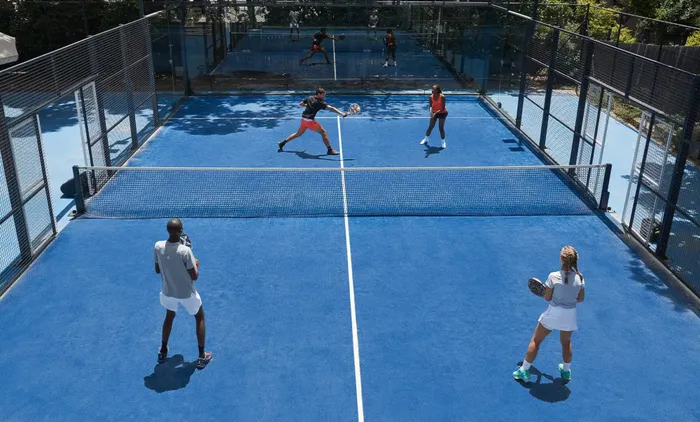Be careful Kimberley padel fanatics, as experts warn of injury risks

The sport of Padel has exploded in popularity in Kimberley over the past year, with courts busy well into the night. But medical experts warn of a rise in injuries – particularly to knees, ankles, shoulders, and elbows. They urge players to warm up properly, choose the right gear, and train smart to stay on court and injury-free.
Image: Supplied / File
Just over a year ago, Kimberley, a city steeped in history and culture, welcomed a thrilling new sports craze when padel, a unique blend of tennis and squash, was taking the recreational scene by storm, thanks to the arrival of AP Padel Courts.
This exciting addition to the city’s sports landscape promised excitement at the time, along with camaraderie and boundless enjoyment for sports lovers of every age and skill level.
Today, there is more than one Padel court in the city, and judging by how long the floodlights stay on at night, the sport is delivering on its promise.
Recently, however, as often is the case with new pastimes, becoming too enthusiastic too quickly can prove to be the undoing of over-eager padel players.
It’s recently come to light that injuries are common among padel players. One journal reports that, with an incidence rate of 3 per 1,000 hours of padel training and 8 per 1000 matches of padel practice, as based on limited literature, the overall prevalence range was 40%-95%. The elbow was the most frequently reported anatomical region concerning location injury distribution, and injuries were mainly of tendinous or muscular origin.
Fun, yes, but be careful
But who can blame players for getting excited and absorbed in the thrill of the game?
After all, Padel is an exciting racket sport that combines elements of tennis and squash, making it a favourite for players of all skill levels.
For those who don’t know this by now, the sport originated in Mexico in the 1960s, and it has rapidly gained popularity worldwide, particularly in Europe and Latin America.
Played on a smaller court enclosed by walls, Padel emphasises teamwork, strategy, and quick reflexes, as players often use the walls to return shots; as I mentioned earlier, this can be absorbing.
The game is typically played in doubles, fostering a lively and social atmosphere. It is easy to learn and fun; however, it comes with its share of injury risks. Common injuries often stem from the dynamic movements involved in gameplay, something that the social player, out for a friendly game after being invited by friends, is unaccustomed to.
These new movements will involve sudden sprints, quick changes of direction, and repetitive motions – movements that our largely sedentary culture is not accustomed to.
Experts flag rising injuries
As expected, therefore, according to a recent report on the IOL website, medical professionals are seeing more padel-related injuries in South Africa as the sport’s popularity grows.
The website quoted Dr Ashley Naidoo, an orthopaedic surgeon specialising in sports injuries, who said:
“Padel is an excellent form of cardiovascular exercise. However, the influx of amateur players has led to a noticeable rise in injuries, particularly affecting the knees, shoulders, elbows, and ankles.”
He noted that both lower limb injuries, such as ankle sprains and calf strains, and upper limb issues, including elbow and shoulder pain, are common — especially among players using heavier rackets or without refined technique.
Physiotherapist Ulaysha Narandas echoed Dr Naidoo’s concerns and stressed the importance of warming up:
“Early match injuries, particularly in the knees and calves, are often due to cold muscles being pushed too hard without adequate preparation,” Narandas said.
Narandas recommends 10 minutes of active movement, such as light jogging, mobility drills, and dynamic stretching before play, and static stretches afterwards to aid recovery.
Injury prevention tips for padel players
Warm Up
- Dynamic stretching: Increase blood flow and flexibility in legs, hips, shoulders, and arms.
- Light cardio: Jog or skip for 5–10 minutes to raise your heart rate.
Strength Training
- Target key muscle groups: Strengthen core, legs, and shoulders with squats, lunges, and shoulder presses.
- Balance exercises: Improve stability to reduce the risk of falls. This menas strenthening your core.
Use Proper Equipment
- Footwear: Wear shoes designed for padel or similar court sports for proper support and traction.
- Racquet: Choose one suited to your strength and style to avoid unnecessary strain. A too-heavy racquet means more strain on your muscles, tendons and joints.
Stay Hydrated and Nourished
- Hydration: Drink water before, during, and after play.
- Nutrition: Eat a balanced diet to support performance and recovery.
Listen to Your Body
- Rest when needed: Don’t play through pain.
- Recognise warning signs: Be aware of early signs of injury, such as persistent pain or discomfort, and address them promptly.
Cool Down
- Static stretching: Post-game stretches improve flexibility and reduce tightness.
- Gentle activity: Don't just sit down after a game. Engage in light activity post-game to help your body transition back to a resting state
Related Topics: